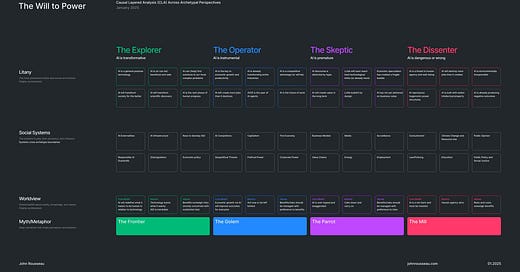By the time I publish this, something new will have emerged in the AI zeitgeist. In just a week’s time, there has been a $500B infrastructure announcement, deregulation by decree, a disruptive new LLM from China (“a Sputnik moment!”), viral speculation about the implications (“narrative collapse”), and a “jolt of panic” in the stock market to follow the vibe shift.
The rapid pace of change and high stakes of AI generate a lot of noise, exacerbated by a dysfunctional information ecosystem that incentivizes real-time analysis and hyperbolic posturing. The result is a trench warfare melodrama among competing narratives that challenges our ability to make sense of emerging developments and limits our capacity to exercise political agency over the future.
One way out of this is to deconstruct the most prolific narratives so that we can think more clearly about the present and envision alternative futures.
Narrative Archetypes
Causal Layered Analysis (CLA) is a foresight method developed by futurist Sohail Inayatullah1. The unique feature of CLA is its four layers of analysis: the Litany (surface discourses), Social Systems (socio-technical systems and dynamics), Worldviews (belief structures), and Myth/Metaphor (deep narratives).
CLA of AI Narratives Across Archetypal Perspectives
I used CLA to explore current AI narratives in terms of four archetypes, adding a horizontal layer to represent competing discourses:
The Explorer: AI is transformative
The Operator: AI is instrumental
The Skeptic: AI is premature
The Dissenter: AI is dangerous or wrong
The archetypes provide a way of juxtaposing alternative perspectives and externalizing assumptions and biases (including my own). They are not meant as fixed boundaries or as a definitive representation of all extant narratives or perspectives.
The map is not the territory—but is useful in other ways. Here, I offer it as an example of practice and a starting point for further discussion.
Note that the systems layer spans the four archetypes, because the systems in play are common to all. Systems are subject to differing interpretations and actions that in turn shape their disposition and vice versa (e.g., capitalism is seen as virtuous by Operators who in turn leverage those attributes, and as extractive/exploitative by Dissenters who seek to disrupt it).
Working out from the systems layer, it is easy to imagine how the Worldviews (below) and the Litany (above) emerge from and reinforce the features of global capitalism. This is the hegemonic narrative: the race for political and market dominance via AGI, entangled with a deterministic belief in progress.
For the Explorers (flush with capital) this manifests a quasi-religious perspective (e.g., that technology “wants” something and is itself meta-agentic), while the Operators see the race as a natural state and the end as justifying the means (e.g. AI as a lever for competitive advantage or creative destruction). Explorers thus emphasize stories of transformative potential and Operators emphasize stories of conquest and disruption.
The two archetypes are adjacent in the model because of the symbiotic relationship between technology and capital, and because they collectively represent the dominant discourse.
On the other end, the Dissenters are inclined to view capitalism as increasingly and irredeemably dysfunctional (e.g. “late-stage”), and thus envision predominantly negative outcomes. They emphasize stories that illuminate externalities and injustice, and represent a growing coalition.
For their part, the Skeptics would argue that the race itself is a construct that distorts reality, exaggerates the capabilities of present and future systems, is self-serving, and thus precludes rational social sense-making. They are waiting for the bubble to burst and will enjoy the moment when it does.
At the Myth/Metaphor level, differences across the archetypes are synthesized as four foundational metaphors:
The Frontier: for Explorers, the sense that they are on a virtuous quest, and that ethical questions can be managed out
The Golem: for Operators, the sense that they can master complexity and control that which they summon
The Parrot: for Skeptics, the sense that they are right, juxtaposed with the paradox that they are largely ignored
The Mill: for Dissenters, the sense that a neo-Luddite resistance is morally needed but similarly imperiled and futile in the face of power
Toward New Futures
CLA is a transformative method that deepens understanding and seeks leverage to create new futures within the context of a larger foresight process. This could occur at different levels of the framework and via different tactics—e.g., by directly challenging and/or reframing worldviews and metaphors, working toward a new synthesis via dialectics, or by identifying intervention pathways in complex systems.
For AI, there is a clear need to evolve our theories of change and develop alternative images of the future that challenge the status quo and reconcile competing narratives. Then, perhaps it would be possible to move beyond passive, default mode thinking and exercise our collective agency to create something new.
Endnote
I have a keynote talk based on this work: New Futures for AI. If that sounds interesting to you or your organization, please reach out.
If you enjoyed this post, please consider a one-time donation to support my independent design, writing, and research.
References
Inayatullah, S., (1998) Causal Layered Analysis: Poststructuralism as method, Futures. 30(8): 815-829
Inayatullah, S., (2008) Six pillars; Futures thinking for transforming, Foresight, Vol. 10 No. 1, pp. 4-21. https://doi.org/10.1108/14636680810855991
CLA is one method within Inayatullah’s “Six Pillars” foresight model. Each pillar contains multiple methodological choices. The six pillars are: 1. Mapping the Present and Future, 2. Anticipating the Future, 3. Timing the Future, 4. Deepening the Futures, 5. Creating Alternatives to the Present, and 6. Transforming the Present and Creating the Future.





Fascinating - I'm having trouble understanding, however, how each of these would imagine a world in the near future. Meaning, how does this analysis become useful?